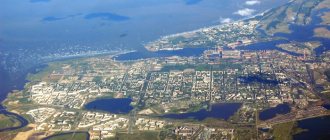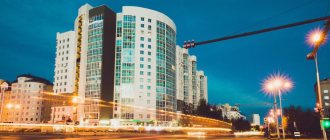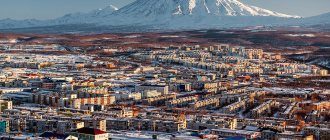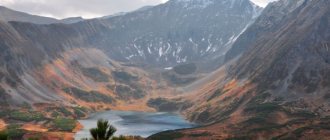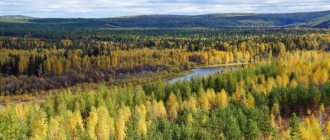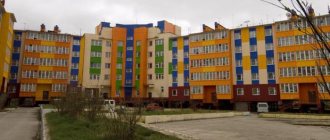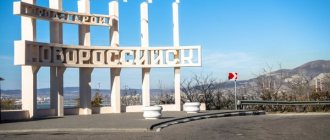CHARACTERISTICS OF PETROZAVODSK
Petrozavodsk is a city in northwestern Russia, the capital and largest city of the Republic of Karelia, the administrative center of the Prionezhsky district. It is located on the shores of the Petrozavodsk Bay of Lake Onega.
Geographical position. Geographical coordinates of Petro in eastern longitude (the zero kilometer is located at the intersection of Sverdlov and Dzerzhinsky streets - near the post office building No. 35, which formerly housed the post office). The city is located on the territory of the East European Plain north of the Olonets Upland and the Shokshinskaya ridge. It is located on the shores of the Petrozavodsk Bay of Lake Onega as an amphitheater on the lake terraces, stretching along the coast for 21.7 km. The city is surrounded by forests on the southwestern side and the Petrozavodsk Bay of Lake Onega. The highest place in the city is Mount Kukkovka (193 meters). Petrozavodsk is located 924 km north of Moscow and 412 km northeast of St. Petersburg. The city of Petrozavodsk, like the entire Republic of Karelia, is located in a time zone designated by the international standard as Moscow Time Zone (MSK/MSD). The offset from UTC is +3:00 (MSK, winter time) / +4:00 (MSD, summer time) due to daylight saving time in that time zone. Petrozavodsk time differs from standard time by one hour, since maternity time is in effect in Russia.
Climate. The climate in Petrozavodsk is temperate continental with maritime features. Winter is long and relatively mild. Summer is short and cool. The average annual temperature is from 0 to +3°. The duration of the frost-free period is 120-130 days. The weather here is unstable, due to frequent cyclones coming from the west. More than half of the days a year are cloudy. Annual precipitation is 550 mm to 600 mm. Spring begins in mid-April, but the return of cold weather is possible in May. Summer begins in the first half of June. Daylight hours are 22 hours in June, 21 hours in July, 16 hours in August. The average July air temperature is 14.5-16.5°. The prevailing winds are easterly directions, bringing prolonged rains. Sometimes in summer Karelia is captured by the northern part of the European anticyclone, and in clear weather the air warms up to 30°. However, such weather can easily be replaced by heavy rains and strong western or cold northern winds. Autumn with humid south-westerly winds or clear but cold (even frosts in the lowlands) weather arrives in early September.
Hydrography. The city is located on the shores of Petrozavodsk Bay, German Bay, Zayaya Bay of Lake Onega, the second largest lake in Europe. Part of the city is also located on the shores of the “open” Lake Onega. Through a system of rivers and canals, Petrozavodsk has access to the Baltic, White, Barents, Caspian and Black Seas, which makes it a port of five seas. There are also lakes in the city: Dennoye, Quarry, Lamba, Logmozero and Chetyrekhverstnoye. Logmozero and Onega lakes are connected by the Solomensky Strait. Several non-navigable rivers flow through the city: Lososinka, Neglinka, Tomitsa, Selga Rechka, Kamenny, Studenets, Studeny and Bolshoi streams. There are about 100 springs in the city. Some of them (“Frog”, “Labor Reserves” (“On Obyezdnaya”), “On Volnaya”, “Neglinsky”, springs on Kurgansky Proezd, Lesnoy Prospekt, in Sulazhgora, several springs on Klyuchevaya) are actively visited by Petrozavodsk residents. From the 12 keys, located in the southern part of the city, the street 12 Keys (now Klyuchevaya Street) and the village (now a residential area) Klyuchevaya got their name.
Vegetation. The territory of Petrozavodsk is 135 square meters. km, including urban land itself - 113 sq. km, the rest is urban forests. The city of Petrozavodsk is not only surrounded by green forests on almost all sides, but also has fairly developed “lungs”. The green zone of Petrozavodsk covers an area of 48.2 thousand hectares, including 1.8 thousand hectares within the city limits. The area of the forest park part of the green zone is 12.9 thousand hectares, the forestry part is 35.3 thousand hectares. Parks, squares and street plantings occupy about 400 hectares, which is slightly more than 14 square meters. m. per inhabitant. Petrozavodsk is one of the most green medium-sized cities in Russia. Since 1951, the Botanical Garden of Petrozavodsk State University has been operating, which is a federal specially protected natural area. The garden area is 367 hectares. In the north of the city there is the Zaozersky Landscape Reserve (Zaozersk Forestry of the Petrozavodsk Forestry Enterprise).
Ecology. In general, with the exception of high water pollution within the city, the state of the natural environment in Petrozavodsk is satisfactory. The main source of water supply for the city is the Petrozavodsk Bay of Lake Onega. The main sources of its pollution are insufficiently treated sewage and wastewater from city enterprises, the waters of the Shuya River, saturated with natural organic matter, and atmospheric precipitation. During the 2000s, the level of air pollution in the city of Petrozavodsk was assessed as satisfactory. Emissions of pollutants into the atmosphere from stationary sources have decreased by 8 times compared to 1991. Important factors in reducing the achieved levels of industrial emissions were equipping enterprises with gas cleaning equipment and converting boiler houses of a number of city enterprises to natural gas, and closing a number of boiler houses. However, due to the increase in the number of individual and route transport, the contribution of their emissions to the overall air pollution of the city has increased significantly; on urban highways loaded with vehicles, the maximum permissible concentration is exceeded several times. Petrozavodsk faces an acute problem of the negative impact of solid household waste. As a result of 25 years of operation, the city landfill in the town of Orzega does not meet sanitary requirements. The city does not have a system for separate collection of household waste, its processing and disposal. Within the city limits, soil contamination with pesticides in excess of the maximum permissible level was not observed. Land pollution with petroleum products occurs in the territories of industrial enterprises and along railways. Contamination with lead and zinc in excess of the maximum permissible concentration is observed in the upper layers of soil along highways and railways.
Historical sketch. Founded in 1703 as Petrovskaya Sloboda during the construction, by decree of Peter I, of an ironworks and cannon foundry (closed in 1734) near the lake iron ore deposit. Peter I visited here several times; a two-story palace was built for him. In addition to this plant, small copper smelting and metalworking plants operated in the settlement. In 1773-74. in connection with the Russian-Turkish war upstream the river. Lososinka built the Alexandrovsky Cannon Foundry Plant, where, along with the production of military products, artistic casting and artistic metal processing were established. In 1791 the plant was visited by. In 1798, the Aleksandrovsky plant was given the exclusive right to manufacture volume measures (weights, scales, steelyards, on which a “secret stamp” was placed to avoid counterfeiting). At the end of the 18th - beginning of the 19th centuries. it was one of the most technically equipped factories in Russia. In 1777, Petrovskaya Sloboda was transformed into the district town of Petrozavodsk. Since 1781, the center of the Olonets province, the city. the center of the Olonets governorship, since 1801 - the center of the Olonets province. In 1856, in the provincial city of Petrozavodsk, Olonets province, there were 7 churches, 862 houses, 57 shops. In 1861, regular steamship communication with St. Petersburg was established. In 1916, the Petrograd-Romanov-on-Murmane (Murmansk) railway was built through Petrozavodsk. In the 19th - early 20th centuries. was known as a place of political exile; the poet (), friend S. Raevsky, and folklorist (1831-85) were exiled here. Since 1920, the capital of the Karelian Labor Commune, in the years. capital of the Karelian ASSR (in the cities of the Karelo-Finnish SSR). During the Great Patriotic War of 1941-45, it was occupied by Finnish troops on October 2, 1941. Liberated on June 28, 1944 by troops of the Karelian Front during the Svir-Petrozavodsk operation. It was badly destroyed. In 1977, the working village of Solomennoye became part of the city (6.9 thousand inhabitants, 1959; 7.3 thousand inhabitants, 1970). In 1972, Leninsky and Oktyabrsky districts of the city of Petrozavodsk were created and in 1988 abolished.
Population. As of 2010, the population of Petrozavodsk is 271 thousand people, which corresponds to 63rd place in terms of population in Russia. The city's population has been declining in recent years due to negative natural growth. Also in 2004, it decreased slightly after a number of settlements left the city. Russians predominate in the population of Petrozavodsk. In addition, the city is a place of compact residence of Karelians (20% of the Karelians of the republic live in the city) and Vepsians (more than half of all Vepsians of Karelia and a quarter of all Vepsians of Russia live in the city). In general, representatives of about 50 nationalities live in Petrozavodsk. According to the Pension Fund Administration, 85.5 thousand pensioners live in Petrozavodsk. The average age of a Petrozavodsk pension recipient is 64 years, more than 6,700 people are already over 80 years old, of which 409 people have reached the age of 90 years or older. Three Petrozavodsk residents will celebrate their one hundred and first birthday in 2010.
Administrative division. Since 1988, the official urban districts of Petrozavodsk (Oktyabrsky and Leninsky) have been abolished. Since then, Petrozavodsk residents have called districts microdistricts, historical toponyms, which are divided into even smaller microdistricts, and they, in turn, can also be divided. Currently, Petrozavodsk includes the following microdistricts: Baraniy Bereg, Vygoinavolok, Golikovka, Drevlyanka, Zheleznodorozhny (Fifth Settlement), Zareka, Zimnik, Ivanovskie Islands, Kukkovka, Klyuchevaya, Oktyabrsky, Okunya Tonya, Onezhsky, Pervomaisky, Perevalka, Sands, Poultry Farm , Radio Factory, Rybka, Sainavolok, Northern Industrial Zone, Silicate Plant, Solomennoye, Sulazhgora, the village of the Sulazhgorsky Brick Factory, the village of the Teplichny State Farm, Tomitsy, Center and the Southern Industrial Zone. The largest microdistricts are Drevlyanka (60 thousand inhabitants) and Kukkovka (50 thousand inhabitants).
Energy. The main source of electricity and heat supply to the city is the Petrozavodsk Thermal Power Plant. About 85% of the heat and about a third of all electricity consumed by the city is supplied from thermal power plants.
Industry. The industry of Petrozavodsk is represented by mechanical engineering and metalworking, forestry and woodworking, construction, food, light and printing industries. The main types of industrial products produced by Petrozavodsk enterprises are electricity, heat, chemical equipment and spare parts for it, paper-making equipment, skidding machines, lumber, including export, planed products, window and door blocks, woodworking machines, sewing and knitted products, leather shoes, sausages and semi-finished meat products, whole milk products, ice cream, bread, bakery and confectionery products, alcoholic beverages, consumer goods, souvenirs, etc.
The importance of the city in the modern world
Petrozavodsk on the map of Russia is located on the lip of Lake Onega. When developing a rich deposit of lake iron ore at the very beginning of the 18th century, by royal decree, a metallurgical plant was built, named Petrovsky in honor of its founder.
The settlement that formed around began to bear the name Petrovskaya Sloboda, which 70 years later was transformed into a county town called Petrozavodsk. Soon it becomes the center of the Olonets province, and then the province. During the Soviet period, Petrozavodsk was given capital status, and today it has also been awarded the honorary title of the Russian Federation “City of Military Glory”.
The city stretches along the coast of Petrozavodsk Bay for more than 20 km, covering an area of about 135 square meters. km. On the eastern and northern sides, the border runs along the coastline of Lake Onega; on the southern and western sides, the city is surrounded by spruce forests.
The port of Petrozavodsk is connected to 5 seas by a system of canals and rivers:
- Baltic;
- White;
- Barentsev;
- Caspian;
- Black.
The Finnish border runs just 350 km from Petrozavodsk, which helps it develop as an international tourist center.
Interesting Facts
- Petrozavodsk is the only large city in the country (except for the Northern capital) that was named after Peter the Great.
- It is called the port of the five seas.
- Geographically, the city belongs to Europe.
- Throughout its existence, it has gone through three stages of development. The city changed not only its status, but also its architectural appearance.
- On April 6, 2015, Petrozavodsk received the honorary title - City of Military Glory.
- Currently there are 280 thousand people living there.
- You can see the northern lights.
Distinctive features of the city
Petrozavodsk on the map of Russia occupies a northern position on the East European Plain, which, together with the proximity of the largest lake, leaves its mark on the climate of the city: temperate continental with marine features. Winter is quite mild, but protracted.
Snow cover persists until mid-April. Summers are cool, rainy and short. Rarely occurring heat is very difficult to bear. There are more than half of cloudy days in the year. The weather is very changeable due to numerous cyclones.
Ecology
Petrozavodsk is considered one of the greenest cities in the country, which has a beneficial effect on its ecology. The city has many feathered inhabitants: swallows and ducks, and bullfinches live in winter. Squirrels live in forests and parks.
The main source of urban water supply is the waters of Lake Onega.
Insufficient sewage treatment and discharges from enterprises pollute water within the city, which is the main environmental problem today. The growth of individual vehicles continuously increases the contribution to urban air pollution.
On the territory of manufacturing and industrial enterprises, as well as along railway lines, land contamination with oil refining products is observed. And along railways and highways there is an excess of the maximum concentration of lead and zinc in the soil. The problem of city landfills and municipal solid waste is very acute.
Vegetation
The city's green zone covers 1,800 hectares, with more than 14 square meters per resident. m of green spaces, parks and squares. Petrozavodsk on the map of Russia is located in the far north zone, which leaves an imprint on the entire Karelian vegetation.
Most of it is occupied by coniferous forests with tall spruce and slender pines, interspersed with juniper and low, crooked birch trees. Many types of moss and lichen. These places are famous for the abundance of mushrooms and northern berries: cloudberries, blueberries, wild rosemary.
Population
There are about 270 thousand urban residents in Petrozavodsk, the following nationalities predominate among them:
| Nationality | Number of thousands | Share % |
| Russians | 218 | 81 |
| Karelians | 13,5 | 5,1 |
| Finns | 7,3 | 2,8 |
| Belarusians | 7 | 2,7 |
| Ukrainians | 6,2 | 2.3 |
| Vepsians | 2,7 | 1 |
| other | 18,5 | 7.5 |
The population density is 3.4 people per 1 sq. m.
Age groups
In 2010, employees of the social protection authorities of Petrozavodsk recorded three centenarians. Their age has exceeded 100 years. In total, more than 85,000 retired persons are registered on the territory of the municipal center. The average age of elderly people is 64. There are more than 6,700 people over eighty years old. There are approximately four hundred people in Petrozavodsk who are ninety years old.
The average life expectancy in Karelia is seventy years. The causes of population mortality are malignant neoplasms, pathologies of the circulatory system, and alcoholism. Doctors managed to reduce the number of maternal and child deaths. Women undergo regular medical examinations. If necessary, they are provided with financial assistance.
How to get there
Petrozavodsk on the map of Russia is located approximately 1000 km north of Moscow and 400 km northeast of St. Petersburg, connected to major Russian cities by transport links of all types.
By plane
The fastest way to get to Petrozavodsk is by plane. The flight from Moscow takes 1 hour 40 minutes. There are also regular flights from St. Petersburg. There are plans to expand the terminal and launch international traffic to Helsinki.
The local airport is located 12 km from the city in the village of Besovets, which is about another 30 minutes. by car. The cost of a taxi is approximately 900 rubles. During the day you can travel by public transport for 57 rubles. The bus ride takes 45 minutes.
By train
The railway connection with Moscow is very good. Every day 7-8 trains depart from Kursky and Leningradsky stations. The fastest way to get there is in 12 hours.
The price of a reserved seat ticket is 1,600 rubles, a compartment ticket will cost 2 times more.
Petrozavodsk is easily accessible from Moscow by train.
From St. Petersburg from the Ladozhsky station the train takes 5 hours, the cost of a seated ticket will cost 1100 rubles. 5-6 trains depart daily.
By bus
You can get to Petrozavodsk in 9-10 hours by bus from St. Petersburg. Ticket price 850 rub. There are also buses to Kem, Sortavala, Belomorsk. Other regular routes from the bus station to Finland.
By car
The distance between the capitals is a little more than 1 thousand km, so it is quite possible to get from Moscow to Petrozavodsk by car in 13-15 hours. From St. Petersburg by car the trip will take about 5 hours.
A car ride around Karelia will bring great pleasure. The roads pass along pine forests, past numerous lakes and wild rivers, surrounded by picturesque rocky ridges.
Transport of Petrozavodsk
Buses almost never run around Petrozavodsk, but run between populated areas. In summer you can find tourist excursion routes. Public transport consists of trolleybuses and GAZelle minibuses, which necessarily pass through the city center. The cost of travel on public transport is 20-25 rubles.
You can take a taxi anywhere in the city or order it by phone. City trips cost between 120-150 rubles. Daily car rental will cost approximately 2-3 thousand rubles. But it makes sense for a country trip to nature or for exploring nearby attractions. In the city it is easier to get around on foot or by taxi, since the parking situation is not very favorable.
You can rent a bicycle. The cost of hourly rental is 200 rubles, and daily rent is 600 rubles. There are quite a few rental points, located at a hotel, hostel or some sports complex. A passport or money may be required as collateral.
Rent a car without a driver inexpensively
Car rental is a service that is becoming more and more popular. In the city you can rent a car without a driver. The average cost is 1000 rubles per day (it all depends on the brand of the car and the providing company).
The largest rental companies: My car rental, Avtoarenda10, Rental 1 and Avto4travel. You must provide a passport and driver's license. A deposit is required. The driver must be at least 21 years old, but in this case only economy class vehicles will be available.
Main attractions
Petrozavodsk is located in close proximity to the northern capital of Russia, which is clearly visible on the map. This left Petrovsky’s imprint on many city attractions, which are concentrated in the historical center, where it is better and more convenient to walk.
Embankment of Lake Onega
The pride of the city and its calling card is the 1.5 kilometer Onega embankment, paved with Karelian granite. It is decorated with very interesting modern statues and sculptures, donated for the celebration of the 300th anniversary of Petrozavodsk by sister cities of Latvia, Sweden, France, Finland, Norway, the USA and Germany.
In the evenings, this is a fairly crowded place where citizens and guests of the capital like to relax. The view of the huge lake is peaceful and mesmerizing in any weather.
Monument "Fishermen"
The composition by American sculptor Rafael Consuegra cements friendly relations with the city of Duluth. This is the first commemorative sculpture installed on the embankment and is called “Fishermen”. It is welded from thin metal tubes. It looks very futuristic, and is especially impressive in the light of the setting sun against the background of the pink sky and endless water surface.
Train Station
The Petrozavodsk railway station building is one of the most beautiful train stations in the country. It was built in the mid-20th century by the architect Tsipulin in the neoclassical style of the late period, and today it is recognized as an architectural monument.
The structure of an integral symmetrical axial composition has a length of 82 m, crowned with a tower with a 17-meter spire. Monumental columns with a recessed portico, Corinthian order, and rich stucco molding are the main decorative elements of the main entrance to the city.
Hotel "Severnaya"
The operating Severnaya Hotel, located on Leninsky Prospekt 21, in the very center of the city, is also considered an architectural part of the face of Petrozavodsk. The building is distinguished by a bright burgundy facade with white columns and is a valuable historical and architectural object of urban development.
Built according to Gutin's design, work on which continued intermittently for about 30 years. Today the hotel has become one of the main decorations and business card of the city.
Monument to Peter I
In Russia's first park complex of birch alleys, planted by order of Emperor Peter the Great, there is a monument to the founder of the city of Petrozavodsk. This cultural heritage of monumental art was created by sculptor Ivan Schroeder in 1872. It is considered one of the best monuments to Peter I.
Petrovsky Square with modern attractions and restaurants is adjacent to the embankment of Lake Onega and occupies an area of 13 hectares.
Monument to V.I. Lenin
The largest monument to the leader of the world proletariat is located in Petrozavodsk. This is at the same time the largest city monument, with a total height of 11 m. In accordance with the climate of the far north, Lenin is depicted in heavy winter clothes with a hat with earflaps in his hand.
The sculpture is made of gray granite from the island of Goltsy, where the camp of political prisoners was located. Today the monument stands on Round Square and is protected by the state.
Governor's Park
Unique historical products from the times of Peter the Great, made at a local factory of that time, are collected in the governor's park. Here you can see ancient cannons with cannonballs and parts of the railway track.
There is a monument to the Olonets governor Derzhavin in the park. At the entrance to the park, in the former governor's mansion, there is a local history museum.
There are many benches in the well-groomed park area, where citizens and guests of the city can relax with pleasure.
Onega Tractor Plant
The historical city landmark of Petrozavodsk is the former Onega Tractor Plant, which today houses the Museum of Industrial History. Interesting photography exhibitions, concerts, fairs and other modern events for young people are held here. Visiting the museum is free, located in building No. 1 on Kalinin Street.
Alexander Nevsky Cathedral
The main cathedral of Petrozavodsk is the Alexander Nevsky Temple, built in a modernist style at the beginning of the 19th century, in memory of the victory in the war with Napoleon. The patron saint has always been highly revered in this land.
Tsar Alexander I gave his consent and his personal contribution to the construction of the stone 5-domed church. Construction was carried out under the leadership of the Italian architect Pietro Maderni. The temple is located on the street of the same name, building number 32.
National Museum
The Karelian Museum of Local Lore is now called the National Museum. It was founded at the end of the 19th century by Governor Grigoriev, and for a long time was located in a church building.
Today, the museum's holdings number more than 200 thousand exhibits, located in 20 spacious halls of the former governor's residence. Unique archaeological finds and exhibits of the fauna of Karelia, ethnographic and historical objects, ancient rock paintings - petroglyphs are presented here.
The building of the 18th century is located in the historical part of the city center on Lenin Square, building 1. You can visit the museum any day except Monday, from 10 to 18 hours. An entrance ticket for an adult costs 200 rubles; children and pensioners can purchase it at a reduced price. And on the 2nd Sunday of the month, everyone can visit the museum for free.
"Karelian Compound"
The extraordinary museum of Petrozavodsk, designed in the form of a traditional hut, will introduce visitors to the peculiarities of life and way of life of the indigenous population in the recent past.
It will be especially interesting for children and adults to learn how they carried water with a rocker, ground grain into flour on millstones, and rocked a baby in a cradle. At the Karelian Compound, festive events are held in the old folk style with tea from a samovar.
Polar Odyssey Museum
The historical and cultural center is nestled in a small wooden house on the shore of Lake Onega near the pier of the yacht club at the address: Rigchina Street, building 37 B. The entrance of the Polar Odysseus Museum is decorated with anchors, and a pirate cat in a vest walks on a chain nearby on a tree.
It's hard to pass by. Guests are invited to climb onto the deck of the brigantine, turn a real steering wheel, learn how to tie sea knots, and inspect the sailor's quarters. In the center there are many skillful models of sailing ships and warships with copper cannons.
There is an authentic antique compass, diving helmet, barometer and other unique artifacts.
In summer, the museum is open daily from 10 am to 5 pm, in winter it is an hour shorter. Ticket price for adults is 150 rubles, for schoolchildren – 100 rubles, children under 6 years old can visit the museum for free.
Puppet show
A favorite place to visit for city children, as well as those who come to the capital of Karelia, is undoubtedly the puppet theater, located on Karl Marx Avenue, 19, in a modern building equipped with the latest equipment.
The team tours throughout the country and Europe and actively participates in various festivals. Two theatrical performances became winners of the Golden Mask. The repertoire includes original puppet productions for adult viewers. Ticket prices vary from 180 to 400 rubles.
Round Square
The historical center of the city is Lenin or Round Square, distinguished by the completeness of its architectural composition in the classicism style of the late 18th century. The director of the cannon factory, Yartsev, began to design the square. After the installation of the monument to Peter the Great, it received the name Petrovskaya.
During the Soviet years, the name of the square changed, modern government buildings were added to its appearance, and a monument to Lenin was erected, and in the post-war years, the appearance of the square was complemented by a memorial complex and an eternal flame. It is located at the intersection of Marx and Engels Avenues, where all city and tourist routes pass.
State National Theater of the Republic of Karelia
The townspeople call the main theater of Petrozavodsk Finnish. His repertoire includes works of Karelian-Finnish and Vepsian epic. An innovation at the national theater was the country's first synchronized translation of the play using headphones. Finnish playwrights are actively involved in productions, and international tours of other theaters take place.
And, of course, they introduce viewers to the best classical and modern Russian works. The Petrozavodsk theater at Karl Marx 19 has two halls . During the day, performances begin at 12 and 14-30 hours, evening performances start at 19 hours every day, except Mondays. The cost of adult tickets starts from 700 rubles.
Musical Theater of the Republic of Karelia
The monumental building with ceremonial columns and a sculpture of Friendship of Peoples at the entrance is a republican musical theater founded in the 60s of the last century from actors of the Russian Drama Theater invited to Petrozavodsk.
The theater's modern repertoire includes classical operas and musical fairy tales, chamber concerts and operettas, and performances of classical and modern ballet. The theater is located on Kirov Square. Performances for adults and children are performed several times a week. The ticket office is open daily from 11 a.m. to 8 p.m., on weekends until 6 p.m.
Botanical Garden of PetrSU
At Petrozavodsk University, a botanical garden was created for research activities in the middle of the last century, occupying an area of about 3.5 square meters. km. Of particular interest to tourists is the most picturesque part of the garden - the arboretum, with zones of European, Asian and North American plants. In the garden there are rocks 2 billion years old - a geological monument - the Devil's Chair tract.
Entrance to the territory is possible from 2 sides: from Botanicheskaya Street and from Prishvina Street. From the public transport stop you will have to walk about 2 km. You can only approach by car from the street. Prishvina, where there is a parking lot. The garden is open to visitors from May to October every day from 9 am to 5 pm. An adult ticket costs 100 rubles, for children – 50 rubles.
Coat of arms
The coat of arms of Petrozavodsk is presented in the form of a French shield. It is divided into two equal parts. At the top, on a golden field, there is a hand emerging from the right side, surrounded by a cloud. The limb faces inward and holds an azure oval shield. Below it are four black cores. They are connected by black chains, forming an indirect cross. The lower part of the shield is divided by three green and two gold stripes. Against their background are 3 iron hammers. The tools symbolize mining and industry.
The artistic composition was adopted by the decision of the Petrozavodsk City Council of People's Deputies on April 19, 1991.
Excursions around Petrozavodsk
Tourist and excursion services are provided in the city on a grand scale. Many hotels offer their own options for walking and bus routes with their own guides.
You can also use private services or choose trusted travel agencies:
- A sightseeing walking tour of the historical part of the city, visiting the main attractions, can take from 2 to 4 hours. There are a lot of options. Accordingly, prices will vary from 200 to 2000 rubles.
- A bus tour to Kizhi for a walking tour of the monuments of ancient wooden architecture will cost 5,700 rubles for 1 person and takes 5-6 hours.
- A popular tour to places of power includes transport service with a guide to a relict volcano, a mystical chair and a pagan labyrinth. Price per adult is 1.5 thousand rubles. For children and students – 1200 rubles. Duration of the trip is 3.5 hours.
- A New Year's adventure in the Karelian forest with an excursion to the residence of Father Frost offers children winter themed entertainment lasting 8-9 hours. The program includes sleigh rides in a reindeer or dog sled, a visit to husky sled dogs and a reindeer farm, outdoor games, gatherings in a tent, entertainment program with a hearty lunch. The cost per person is 2900-3700 rubles.
- A very interesting 8-hour walking tour with travel by bus: Kivach - husky dog kennel - Girvas - Martialnye Vody, takes about 8 hours. It is carried out for a small group of 2-4 people, the cost per person is 4.5-5 thousand rubles. The program includes visiting a waterfall and an ancient Karelian volcano, tasting dairy products and lunch on a farm, visiting and communicating with husky dogs. Guests will also get acquainted with the first Russian resort on healing waters, founded by decree of Emperor Peter I, and taste waters from a healing spring.
When is the best time to go?
The city is beautiful at any time of the year. But most often the capital is visited in the summer, when it is warm and you can go swimming. Also, only in summer is it possible to get to the main attractions by water.
It is best to go to Petrozavodsk from May to September to have a chance to attend several excursions.
Don’t forget about the winter period, but it will no longer be possible to visit some attractions. Snowdrifts, snowmobiling, cross-country skiing and much more awaits guests in the winter.
Hotels in Petrozavodsk (cost, what is included, where they are and how to get there)
Table:
| Hotel | Address in Petrozavodsk | Room price in rubles | Features of accommodation |
| Onego Palace Hotel | st. Kuibysheva, 26 | from 2400 | On the shore of Lake Onega. Comfortable rooms. Restaurant with banquet hall. Hearty breakfasts. There is an indoor pool. Bathhouse. Massage. Fitness center with gym. Free parking. |
| Onega Castle | st. Fedosova, 44 | 2500-5700 | Proximity to the lake, beautiful views of the city surroundings. Restaurant. Bar. Parking. Transfer possible. |
| Petrozavodsk | st. Krasnaya, 28 | 390-3000 | City center. Parking. There is no restaurant, you can cook in the shared kitchen. |
| Guest House | st. Muezerskaya, 100 | 400 | Location in a park area. It has its own beach. Parking. Car rental. Terrace. B-B-Q. Nutrition. Excursion service. |
| Hotel Prionezhsky | st. Fedosova, 46 | 1900-4700 | Restaurant. Sauna, spa treatments. Parking. |
| Karelia Hostel | st. Rigachina, 20A | 1500 | New mini hotel 10 min. from Onezhskaya embankment. Kitchen with necessary equipment. Washing machine. Host computer. |
| Northern | Lenin Avenue, 21 | 2000-6200 | In the historical center of the city. Restaurant with banquet hall. Open terrace. Garden. Evening program. Gym, sauna, massage, solarium. |
| Peter | Shuiskoe highway, 16 | 1100-2500 | Tour agency. Restaurant. Parking. Pets are allowed. |
| Hostel Pandaminium | st. Frunze, 14 A | 635 | Proximity to the train station. Large living room. Full kitchen with free tea and cookies. Sauna. Washing machine. |
Where to eat?
The capital of Karelia has many wonderful restaurants and cafes where you can have a tasty and inexpensive meal. And good places may not necessarily be located in the city center. Prices are reasonable. Each guest will find a suitable place for their budget. Below are both high-level establishments and inexpensive canteens with homemade food.
- "Reindeer moss". A modern city restaurant located in the very center of the city.
- "Deja vu." This is a European cafe with quality cuisine. Is one of the most popular places in Petro. The first specialized store of Japanese cuisine. There is free delivery and reasonable prices.
- Dining room "Hermes" at st. Krasnaya, 31. Here you can plunge into the atmosphere of your favorite and homemade tastes.
- "Bavarius". The most meaty place on the map of Petrozavodsk. Here guests will be treated to shanks and sausages made from minced meat according to their own recipe.
I recommend taking an unusual excursion to Petrozavodsk for gourmets: taste the city!, where you will visit gourmet restaurants, cozy cafes, a warm and lamp-lit teahouse.
What to bring
The most delicious and useful common gift and souvenir can be called balm from Karelian herbs, jams and tinctures from northern berries. They are sold not only in souvenir shops, but also in supermarkets.
Petrozavodsk is also famous for its unique crafts made from rare Karelian birch wood. The most beautiful paintings, boxes, watches, souvenirs such as magnets, salt shakers and even flash drives for computers are made from it.
Karelian embroidery in red and white colors, created by craftswomen using ancient technologies, has recently become very popular.
Ornaments from geometric shapes are intricately formed into various shapes of animals, birds and people. The healing properties of shungite are known far beyond the borders of Karelia, and this is where this healing mineral is mined. You can bring unusual souvenirs or just a few black pebbles with metal veins as a souvenir and for purifying water.
Patchwork items are a common lasting gift from Petrozavodsk. This could be a quilt, potholders, tablecloth, pillowcases or blanket. You can choose elegant bright interior items of any color.
Karelian ceramics made from red local clay can become a practical souvenir of a trip to Petrozavodsk. The choice of products is very diverse: from a decorative vase to a practical pot. Everyone can choose according to their taste and budget.
Petrozavodsk is an amazing and interesting place, which, despite its remoteness on the map of Russia, is very popular with tourists from all over the country and guests of Karelia.
Article design: Oleg Lozinsky
Marcipal waters
Interestingly, Peter the Great founded a resort here called “Marcipal Waters”. This establishment is located near Petrazovodsk.
Mostly people with heart problems come here. The positive results of treatment and prevention of diseases are very well influenced by the environment and nature of Karelia .
It is very calm and quiet here. It is not surprising that in such a peaceful environment, the treatment process proceeds profitably and even with unforgettable pleasure.
Many patients of the sanatorium speak positively about their stay at Marcipal Waters.
At the first opportunity, they try to return here again, and also actively recommend this place to their friends who, like themselves, want to find a good place for relaxation and treatment.



